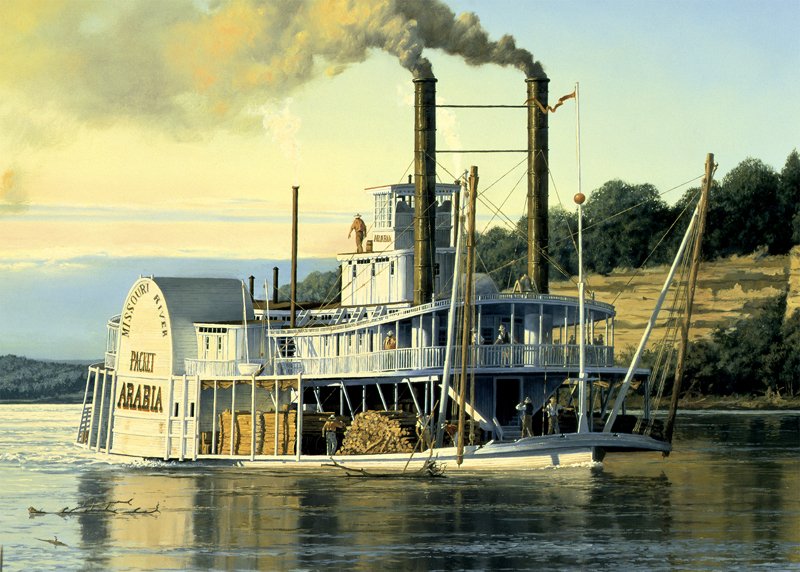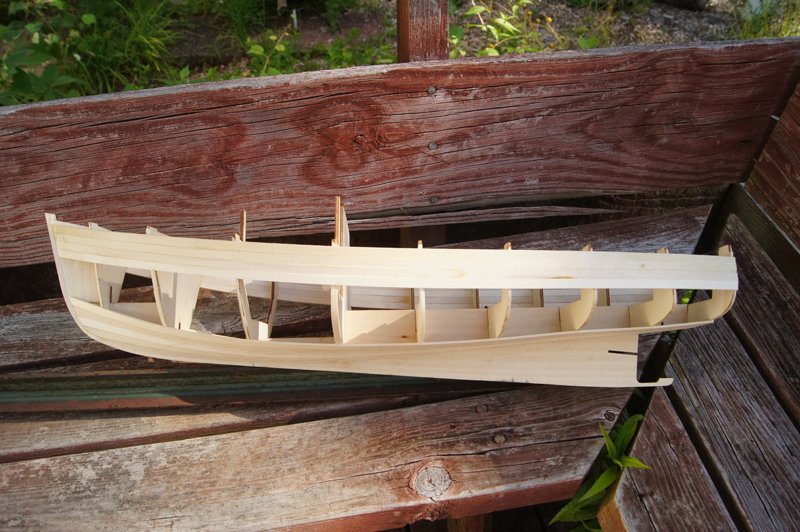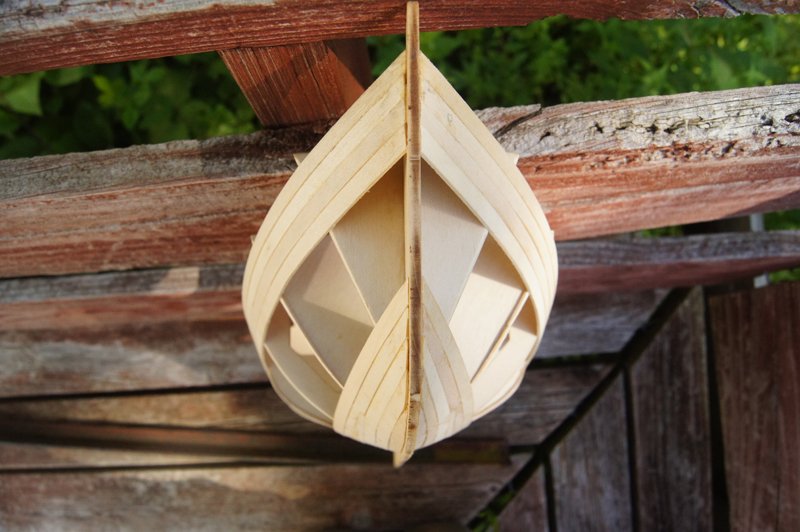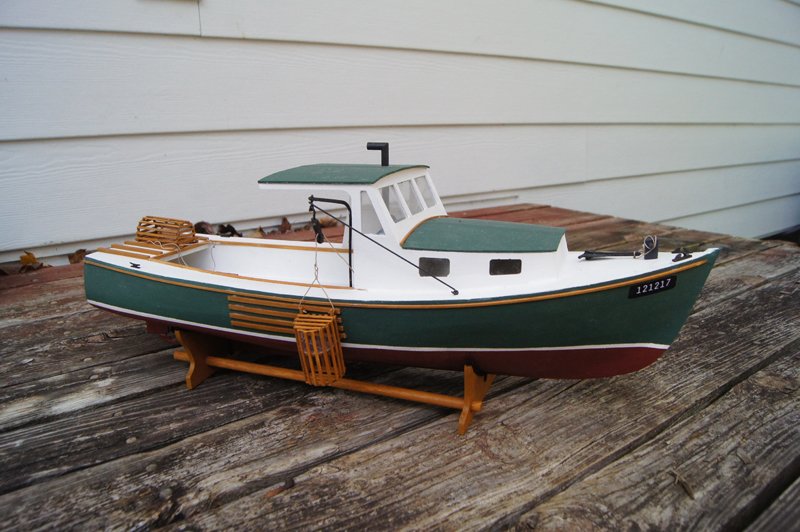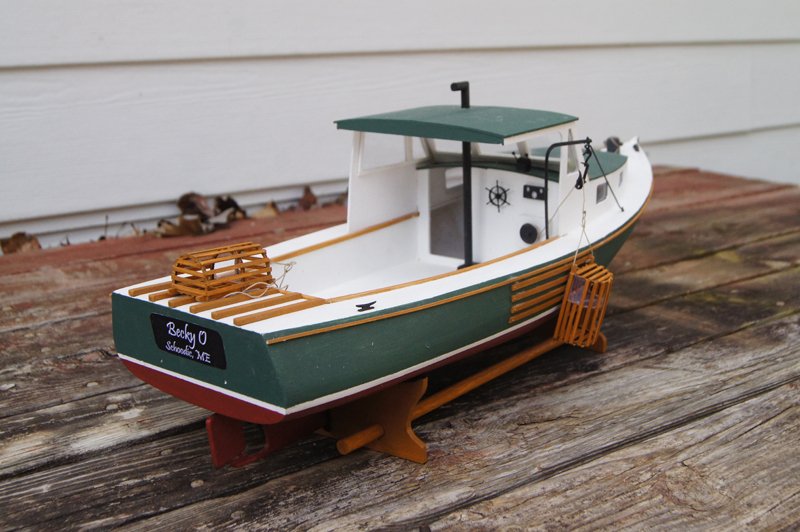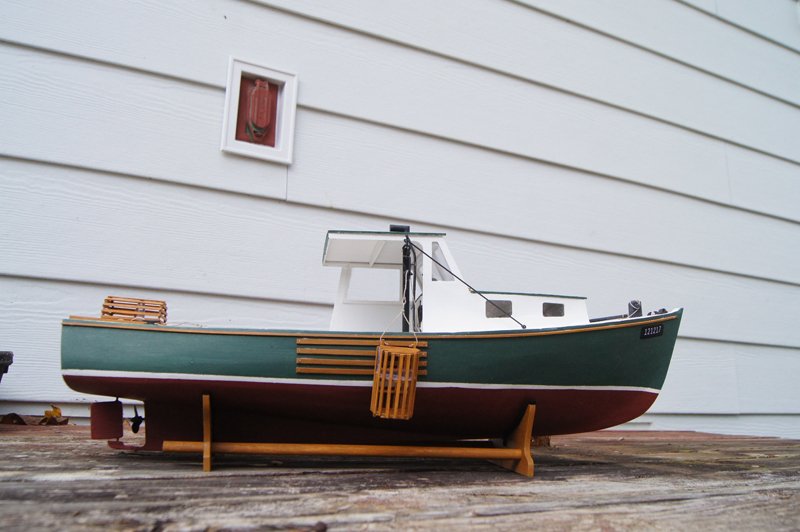-
Posts
3,378 -
Joined
-
Last visited
Content Type
Profiles
Forums
Gallery
Events
Everything posted by Cathead
-
I built this last year. Although I used all the kit parts, I agree that the castings for the carriage are of relatively poor quality in addition to not being as authentic as wooden parts. I also found that many of the rings were cast solid and needed to be drilled out, which was very difficult to do without breaking the soft metal of the rings. I think you'll definitely do well to build your own carriages and use good metal rings as needed. That being said, it's definitely a fun build and a neat little display piece (I did both this and the carronade, and they look good together in my opinion; a photo is here if of interest). Looking forward to seeing what you do with this kit.
- 82 replies
-
- naval smoothbore
- model shipways
-
(and 1 more)
Tagged with:
-
Given that this is something of a seat-of-the-pants build, I wanted to figure out a way to lay out the hull framing and test it before doing any permanent work. This is the approach I hit upon: Rather than make bulkheads spanning the hull, I'm going to make them one side at a time, as if I was building a half-hull model. This way I can pin each half-bulkhead in place until I get the whole half-hull laid out. Then I'll fair the bulkheads (using tape to insert temporary spacers for stability) so I can test whether their shape produces the run of planking that I want. If it doesn't, I can easily pull any bulkhead and replace or reshape it as needed. Once I'm happy with this side of the hull, I can use these half-bulkheads as templates to make the other half. Sharp eyes may notice that #2 appears to extend too far beyond the line of the hull. This is intentional; it's hard to see here but that piece is higher than it needs to be on most of the deck side to accommodate both the horizontal camber and the longitudinal fall of the deck. I accomplished that by gluing an extra strip on the upper side, something I haven't done yet for #3-5. So #2 looks unnaturally long but it won't be once everything is shaped properly. That's the idea, anyway. The basic wood I'm using is a set of (poplar?) strips my stepfather passed along as scrap from his shop (he's a professional cabinet-maker and all-around woodworking artisan). I've been holding onto these for years, thinking they'd be useful for something, and it turns out they're nearly the perfect dimensions for framing in this hull. As all my modelling work happens on a tight budget, I'm very happy to put these to use. They're solid, straight, and nice to work with. For now, the work is just the repetitive measuring and cutting of half-bulkheads. The middle portion of the hull will be square, so I can mass-produce those a bit more quickly. The stern will be the most challenging, as here the hull curves back in on itself similar to an ocean-going vessel (unlike the far simpler sterns of sternwheelers), so there will be some extra-careful carving and shaping here. I'll update again when there's sufficient progress to show off. Comments, critiques, and suggestions are always welcome.
- 599 replies
-
- sidewheeler
- arabia
-
(and 4 more)
Tagged with:
-
That'll be a fun trip for sure. The museum hasn't changed that much overall but they have a lot more items from the cargo on display now. If you want company, I might be able to join you. We live a few hours away and it'd be fun to visit the museum together.
- 599 replies
-
- sidewheeler
- arabia
-
(and 4 more)
Tagged with:
-
The Arabia as envisioned by artist Gary Lucy; used with permission of the Arabia Steamboat Museum As a resident of rural Missouri, not far from its eponymous river, I've long been fascinated by the less-well-known steamboats that worked the “Big Muddy” from the river’s mouth at St. Louis all the way to the head of navigation at Fort Benton, Montana, an astounding 2,300 river miles. Most modern impressions of interior American steamboats are of the large, highly-decorated “floating wedding cake” craft of the lower Mississippi River, which represent a small fraction of the full diversity of steamboat design and use. Those craft are, to my eye, too gaudy by far, the equivalent of overbuilt Disney cruise liners; I don’t care for them, and I really don't care for the highly inaccurate and toylike models that most kits claim represent American riverboats. I prefer the smaller, leaner steamboats of the upper rivers, those designed to risk the rocky ledges of the Ohio River (such as the Chaperon) or fight their way up the narrow, shallow, ever-changing treacherous channels of the Missouri River. By the 1850s, their design had been nearly perfectly adapted to the unique conditions they faced, changing little for decades to come, until railroads finally cut them off at the knees. Two of the most well-known and well-documented steamboat wrecks from this period are the Bertrand (a sternwheeler that sank in 1865 and was rediscovered in 1968) and the Arabia (a sidewheeler that sank in 1856 and was rediscovered in 1988). Both boats now have excellent museums displaying their highly diverse and extraordinarily well-preserved cargo; the Bertrand at a wildlife refuge north of Omaha, Nebraska, and the Arabia at a museum in downtown Kansas City, Missouri. I began researching the Arabia in earnest in spring 2017, writing about and documenting my research and sources for information in a separate thread, but am now ready to begin building the actual model. The text above is copied and rearranged from that thread, but I felt it provided an important introduction to this project and so should be repeated for those who may not go back and read the research thread. Although I am far from a master modeler, this will be my third scratchbuilt Missouri River steamboat. I built a rudimentary version of the Far West when I first became interested in wooden ship modeling, and later tackled a fully-framed and interior-detailed version of the Bertrand. Both of those were built in 1:87, a comfortable scale for me as a former HO model railroader. However, for this project I wanted a new kind of challenge, so decided to build the Arabia in 1:64. The model will be around 32 inches (81 cm) long, allowing for more detail to be added overall. At the same time, though, I've decided not to recreate a fully-framed hull and interior as I did with Bertrand, for several reasons. First, that was a lot of work and material and would be even more expensive at 1:64, and I've already done that style now. Second, creating a framed model of Arabia would be both redundant and speculative; the museum preserves her stern intact for anyone to see, while the rest of the hull wasn't well-documented by the salvage team, so I'd be guessing more than I did with Bertrand (which was meticulously documented by an archeological team). Third, I just like the idea of a complete exterior model this time, trading a bit less interior detail for more focus on the overall appearance and higher detail allowed by the larger scale. Basically, this is just what I feel like doing this time, and doing a project the way you want to is part of what makes it engaging. Although my initial plan was to develop a full set of blueprints for this project, that effort has stalled. It just isn't working for me to spend that much time on a computer, which I already do professionally as a freelance science editor. I'd rather spend my downtime working with wood than with pixels. So I stopped after developing a basic outline of the project and will just dive in, holding the design in my head and in various rough sketches and notes. This is, in fact, an authentic way to proceed, as riverboats in this era weren't built from printed blueprints either (one reason few construction records exist) but were simply laid out and built by artisans on the frontier shores of the Upper Ohio River. So any mistakes or quirks I may build into my Arabia as I proceed from the seat of my pants will be, at worst, a tribute to the real vessel's construction. Above are my loose outlines of her design. The real Arabia was about 170' long and 30' wide (hull, not including the wheels) and drew about 5'. And the sketches from which I'm getting started. There is no definitive information on the shape of her hull, other than the stern-most portion, which I've based on photos and measurements I took at the museum. So for the rest I've adapted a representative hull profile for the era from Alan Bates' The Western River Steamboat Cyclopoedium. The wheel and its supporting cylinder timbers are drawn directly from measurements I took at the museum. Centered within these drawings is the central internal bulkhead/keel I've laid out. These riverboats didn't have external keels the way normal ships did; their bottoms were generally perfectly flat with a stronger internal keelson instead. In this case, I'll be laying out horizontal bulkheads against this longitudinal one, just like a regular plank-on-bulkhead build. Hopefully now that I've laid the keel, so to speak, I can keep progress coming steadily. Thanks for reading, and for offering any ideas, suggestions, and criticisms that come to mind. I'd sure appreciate it if anyone points out concerns or problems that I can either explain or correct as I go along, as again I'm not a master modeler, just an ambitious one. Table of Contents Below I link to posts starting various portions of the build. This is intended to help folks looking for information on specific aspects of steamboats or their modelling, or just those wanting to catch up on a certain section. I'll try to keep this updated as I go along. Framing the hull Guards and main deck framing Planking the hull Cylinder timbers & engines Planking the main deck Paddle wheels Boilers Main staircase & chimney breechings Framing the boiler deck & superstructure design Boiler pumps & other main deck details
- 599 replies
-
- sidewheeler
- arabia
-
(and 4 more)
Tagged with:
-
Regarding the inflatable, I wonder if adding some seams would help with the realism, especially internally? It would break up the long run of smooth plastic and give some more visual interest. Looks nice, nonetheless
- 101 replies
-
- L Toile
- Billing Boats
-
(and 1 more)
Tagged with:
-
Daria, Mrs. Cathead (who is a scientist) thinks it's fantastic that you're interested and engaged in such things, as do I! I've been sharing all your updates and photos with her. There isn't much in the nautical way out here in the central US, so I quite envy you the chance to work on such a Viking ship (especially as someone of Norwegian descent).
-
One method I've used a lot for edge-bending planks is to cut a scrap piece into a gentle curve, around which I can bend the plank. I find that it helps to have a solid curve to press up against, it lessens the potential for the plank to buckle or form a sharp curve in one place. This form doesn't have to be true to the final curve, just something roughly similar. I clamp it down first and then bend the plank around it. This is roughly what you're already doing in bending the second plank around the garboard, just more standardized since you won't be able to do that every time. From what I can tell, you've definitely got the right idea and it's looking good.
-

review BlueJacket Shipcrafters Lobster Boat: A Review
Cathead replied to Cathead's topic in REVIEWS: Model kits
Ragove, that's interesting that you had quality issues, as I didn't. The only part I broke was the very thin port-side door frame which sticks up alone for part of the build, and that was my fault for rough handling. I was able to reattach and brace it with no problems. Otherwise the frames stood up well to sanding and shaping, and the planking material was strong but flexible. I did hear from Nic at BlueJacket (I hope it's ok to share this) that the kit is due for an upgrade, which would be exciting as it's fundamentally an interesting model and well worth building. -

Steamboats and other rivercraft - general discussion
Cathead replied to Cathead's topic in Nautical/Naval History
The term actually isn't unique to riverboats. As far as I know, "Packet" originally referred to an ocean-going ship carrying mail, passengers, and/or smaller freight on a regular schedule or route. The term was simply adapted to interior American riverboats that followed a similar function. So a riverboat that followed a regular schedule between, say, New Orleans and St. Louis might be called a packet, whereas one that sought out trade wherever it happened to be or didn't stick to a schedule wouldn't be. For example, the boats that headed for the Upper Missouri River from St. Louis each spring after the ice broke up wouldn't be considered packets because they only made one or two trips a year due to the very long distance, and weren't following a schedule so much as heading upriver with goods for the mining camps and intending to bring back gold from Montana (more like an Indiaman or galleon than a packet). I don't know the actual origin of the term, but have always assumed it referred to the smaller "packets" of mail that such ships/boats tended to carry, as opposed to regular merchantmen carrying bulk cargo. I hope Kurt or another expert knows the answer to that, or can offer any correction to my understanding above.- 281 replies
-
- Steamboats
- riverboats
-
(and 3 more)
Tagged with:
-
This may be a trick of the photo, but to my eye it seems that your sheer plank doesn't quite curve smoothly along the whole run of the hull. At about the 7th frame from the stern, there seems to be a sharper curve transitioning from relatively straight sections fore and aft of that point (especially fore). I mention this, not to be critical, but because if this isn't an optical illusion it may give you trouble as you continue planking. Ideally that plank should follow a smooth, sweeping curve with no sudden changes; any of those later could ripple through the subsequent planking and give you wider gaps between the planks or more difficulty getting the planks to really follow the hull smoothly. My apologies if it's just optical or if suggesting this is out of line, but I've always hoped others would point out potential concerns to me and wish to do the same for others.
-

review BlueJacket Shipcrafters Lobster Boat: A Review
Cathead replied to Cathead's topic in REVIEWS: Model kits
Nice, Kurt, thanks for sharing! Your extra detail looks especially nice. Your shade of green seems more marine, but I chose the exact color scheme I did because it's quite literally the same as our house. After I rejected the kit paints, I decided to use the house paints I already had on hand for our siding and trim as I'm budget-conscious and really didn't want to order yet more paints (I wish I'd thought of that in the first place). I know that house paints are generally not good for models because the texture is so much coarser, but given the large scale and low detail of this particular kit, I thought it would work well enough, and as it's a gift for my mother any subtle reduction in textural quality is overruled by the "cool" factor of a meaningful color scheme. If you look closely you can see the texture isn't ideal, but it looks great from more than a foot or so away, and that's good enough for me on this one. Next up I'm finally getting back to my long-delayed steamboat Arabia project, which has been languishing all summer. It's still in design mode but I'm close to actually doing some physical mockups that will help me move forward. -

review BlueJacket Shipcrafters Lobster Boat: A Review
Cathead replied to Cathead's topic in REVIEWS: Model kits
I forgot to mention one related point. I also purchased the separate paint kit for this model, but had a serious problem. I have always used water-based paints because of their easier cleanup and lower toxicity (I work in my living room and both my wife and I are fairly sensitive to chemical odors). I did not realize that the paint kit was oil-based until I received it (although I should have as the list includes thinner). The odors from the open bottles permeated our house and gave me nausea and a headache. Even when I tried painting outside, when I brought the dry model back indoors it still reeked of chemical paint smell. I closed up the entire paint kit, set it aside, and never touched it again. I used water-based paints instead with no problems, as is my normal practice. So if anyone would like a complete, nearly unused set of paints for this kit, I'd be happy to part with them rather than having the bottles sit around going unused. If you're less sensitive than I am, or have a better painting setup, they may well work great for you. Just not for me. -
BlueJacket Shipcrafters seems to be under-represented in build logs on MSW, despite their reputation as a quality American model company that’s been in business a very long time. I recently completed their Lobster Boat kit and thought I’d write up a quick review, as there aren’t any build logs for this kit on MSW (I didn’t do a log myself as I wanted a break from documenting model work and intended this to be a relatively quick, relaxing build). Overall, I enjoyed building this kit, though there were a few things future builders might consider. Above is my finished model, built and named for my mother, who has long loved Maine, especially the Schoodic Peninsula. The number boards commemorate this year's birthday, when she'll receive this model. It's finished in the same green and white color as my current house. Positives: Good-quality materials. All the wood was solid and easy to work with, and the castings were clean and straightforward. Clear and accurate plans. These matched the kit’s parts and were helpful as a reference. I could have used them to scratchbuild this without the instructions or materials. Not too complicated. The kit might be tough for a complete beginner as it assumes a bit of knowledge, but almost anyone could figure these bits out and it’s pretty straightforward overall. It doesn’t have a lot of detail, which I think is good as it keeps the cost down and lets you choose whether you want to invest the time and money into creating a more detailed custom version. Concerns: The written instruction booklet is less than ideal. The black-and-white photos are very grainy and make it difficult to see any useful detail. For example, I was essentially unable to determine the planking pattern used because the photo was so blurry. Also, the text is presented in a long, linear block that could really use better organization and editing. Photos and drawings are often placed nowhere near their relevant text, resulting in lots of flipping back and forth trying to make sense of a given step. There is some "curse of knowledge" in places, where the instructions refer to a given part without defining what that is in real life or providing a clear diagram or label for the model. Bow design. The kit’s default is to use a large carved block at the bow, rather than planking all the way to the stem. With no experience, I had a very hard time carving and shaping this properly and finally gave up and reverted to planking the whole hull, something I have more experience in. That may just be my own problem, but it’s something a beginner should consider. Also, the added material needed to plank the whole hull (rather than just up to the bow block) meant that I exhausted the kit material and had to use a few pieces of my own scrap to complete the work. Beware of this potential if you decide to fully plank the hull rather than carving the bow. A few oddities in the proper fit and size of pieces. For example, several of the hull frames really didn’t line up with the others, requiring me to add a 1/8” strip along the frame to match the flow of the planking or to carve/sand away material. Some of the cabin pieces also needed significant sanding or additions to form up properly. None of this was particularly difficult, but did mean that builders should be careful to check everything before gluing. For example, see the following two photos: In the photo above, note that the run of lower planking really bows upward at the third frame from the stern. I somehow missed this when checking my fairing and planking run. It isn't really noticeable on the finished model because both the paint and position hide it from clear view, but this clearly needed extra material added to the frame. In the photo above, you can see the thickness of extra material I needed to add to both sides of the second frame from the bow to match the natural flow of the planks. It's more obvious on the right side due to the shadow effect, but it's the same for both. The fourth frame from the bow has similar material attached to widen it, while other frames needed to be sanded down by a similar margin. Getting a smooth run of planking was more work than I expected, though not particularly difficult. Here are two more photos of the completed model from various perspectives: Overall, I certainly recommend this model as a fun build. True beginners should be cautious and would benefit from carefully thinking through every step, test-fitting everything, and doing some research on the side to understand certain aspects of kit-building that are taken for granted by the instructions. Although I mildly criticize the instructions and a few parts above, they were still far better than those of the Corel Ranger that I built before this. Overall, the concerns were minor and easily dealt with by common sense and careful work, and the result is a quite attractive model (in my humble opinion). It has a lot of potential for adding extra detail if you really want a realistic appearance; for my mother, I was happy with a representative model that captures the feel of these iconic American work boats without much fuss. This was my first BlueJacket kit and I would definitely purchase another.
-
Very nice work so far. I've never worked with PE before so it's interesting to see your progress and methods.
-
That seems like it would cause problems later on. I've always liked planking when I can turn the hull over and work on it; if there's more delicate structures on the deck, won't that make it harder to work on planking later? Or at least require the construction of a proper supporting rig to protect those structure?
-
Oops, you're right. I searched for O scale figures and didn't double-check that Google returned the right scale. HO is actually about half the size (hence Half-O scale), at 1:87, so those would actually be midgets. But here's an example that should work. Overall, your best best is still to search for model railroad figures with a western, old-time, or steam-era theme, making sure they're American or at least not blatantly European. The company I linked to there, Walthers, is about the biggest retailer of model railroad products in the US and a good starting point for a search. I have no idea if/how they ship overseas, but their catalogue will at least give you a sense of what's out there.
-
Chris, 1:50 is very close to the model railroad O scale (1:48), for which there are a variety of figures available. If you like for "old-time" or "western" style figures, you'll be in roughly the right time period (mid-late 1800s). Here's one example I found with a quick search. Just be careful about European brands like Preiser, their prototypes tend to be European and you could get some very strange uniforms and styles for a riverboat on the American frontier. As for color, I definitely feel that white is the correct choice. It was by far the most common color and thus will "feel" authentic. As you suggest, shoot for a thin coat of paint that lets the planking show through; it would have been visible on the real thing. You really can't go wrong with a white hull and superstructure, dull red/brown main deck and wheel(s), and dark grey/black tarpaper covering on the exposed upper decks.
-
Yeah, Way's is a lot of fun to browse, though a bit mind-blowing in its diversity and complexity. Once you've read through the logs Kurt suggested, I'd also suggest Glenn Grieco's Heroine and, humbly, my Bertrand (see link in signature).
-
Over lunch I skimmed through all my riverboat references and could not find a single reference to caulking or any other treatment of the seams between deck planking on American riverboats. Even the archeological report on the Bertrand didn't say anything about this, and they documented the location and dimensions of every single plank on the main deck. It's an interesting question. As Kurt notes, the only real threat would be rain, and most of the main and boiler deck areas were covered by higher decks eventually capped with tarpaper, such that the only real deck area clearly exposed to the weather without tarpaper or other covering would be the bow area and the outer edges of the main deck. The guards (if present) certainly wouldn't need caulking as they didn't cover any hull area. So my guess would be that caulking either wasn't used or was done only in the bow area of the main deck. On the other hand, given the potential intensity of rainstorms in the Mississippi Basin, a riverboat deck could easily be awash in minutes from driving, blowing rain, and many boats had open cargo areas on the main deck with minimal superstructure to block wind-driven rain. So it's not hard to imagine a thunderstorm dropping multiple inches of rain in short order that could blow/leak down into the hold, causing potential problems for cargo stored there. But my guess that this just wasn't enough of a problem to warrant caulking; a competent crew would simply not store any water-sensitive cargo far forward in the hull (the only place really potentially prone to meaningful leaks from above) or use basic tarpaulins as necessary. I'm interested to know what Kurt finds out from his sources.
-

size of people
Cathead replied to Snow's topic in Discussion for a Ship's Deck Furniture, Guns, boats and other Fittings
Well said, Imagna, it's not about laziness but about efficiency. Yes, if you only need one calculation, it's quite easy to do the math. But at the scale of a full build, there's nothing wrong with setting up a more efficient way to do the work. Or should we all hand-cut every bit of railing rather than using a stopper to automate the cuts? -

size of people
Cathead replied to Snow's topic in Discussion for a Ship's Deck Furniture, Guns, boats and other Fittings
As I mentioned earlier, I went ahead and wrote up a tutorial on using spreadsheets to calculate model conversions. This is exactly the kind of tool that would let you quickly figure out various measurements at 1/60 (such as a person's height) without having to remember and set up equations each time or search for the right online conversion tool. I mention it here at the risk of self-promotion because it seems pretty relevant.
About us
Modelshipworld - Advancing Ship Modeling through Research
SSL Secured
Your security is important for us so this Website is SSL-Secured
NRG Mailing Address
Nautical Research Guild
237 South Lincoln Street
Westmont IL, 60559-1917
Model Ship World ® and the MSW logo are Registered Trademarks, and belong to the Nautical Research Guild (United States Patent and Trademark Office: No. 6,929,264 & No. 6,929,274, registered Dec. 20, 2022)
Helpful Links
About the NRG
If you enjoy building ship models that are historically accurate as well as beautiful, then The Nautical Research Guild (NRG) is just right for you.
The Guild is a non-profit educational organization whose mission is to “Advance Ship Modeling Through Research”. We provide support to our members in their efforts to raise the quality of their model ships.
The Nautical Research Guild has published our world-renowned quarterly magazine, The Nautical Research Journal, since 1955. The pages of the Journal are full of articles by accomplished ship modelers who show you how they create those exquisite details on their models, and by maritime historians who show you the correct details to build. The Journal is available in both print and digital editions. Go to the NRG web site (www.thenrg.org) to download a complimentary digital copy of the Journal. The NRG also publishes plan sets, books and compilations of back issues of the Journal and the former Ships in Scale and Model Ship Builder magazines.



